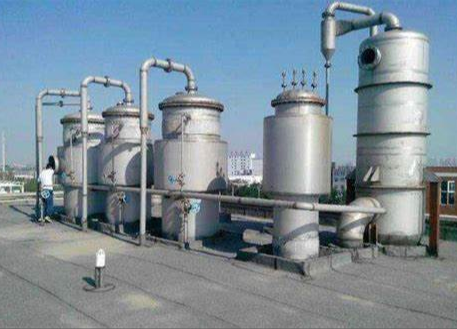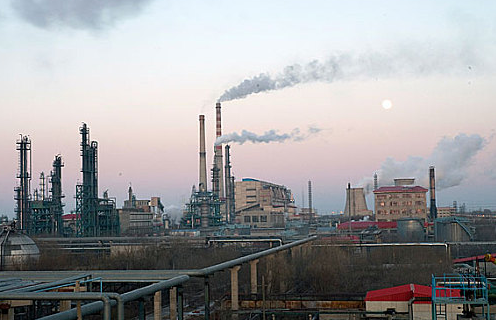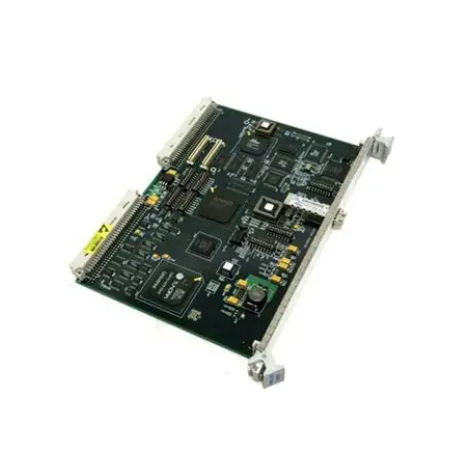Open the door of petrochemical industry and coal chemical industry
Overview of petrochemical industry and Coal chemical industry 1. Process overview: differences in structural components and variable process paths
Petrochemical industry refers to the processing industry that uses oil and natural gas as raw materials to produce both petroleum products and petrochemical products. Specifically, the petroleum processing industry can be divided into two major industries from the perspective of processing and use, one is that petroleum through refining can produce a variety of fuel oil (such as gasoline, kerosene, diesel, etc.) and lubricating oil as well as liquefied petroleum gas, coke, paraffin, asphalt and other petroleum products, that is, the refining process or petroleum refining industrial system; The second is to separate petroleum into raw material fractions, crack raw material oil and gas to generate basic chemical raw materials represented by ethylene, propylene, butadiene, benzene, toluene, xylene, and then use these basic chemical raw materials to produce a variety of organic chemical raw materials (about 200 kinds) and synthetic materials (plastics, synthetic fibers, synthetic rubber), that is, the petrochemical system. Oil refining and chemical industry depend on each other, mutual penetration, huge and complex, jointly promote the development of petrochemical technology, but also improve the economic benefits of petroleum, petroleum industry has become one of the pillar industry sectors in China.

Coal chemical industry is a process in which coal is converted into gas, liquid and solid products or semi-products and chemicals through chemical processing. From the processing process of coal, coal chemical industry mainly includes coal dry distillation (including coking and low temperature dry distillation), gasification, liquefaction and synthetic chemicals. Among them, coking is the earliest process in the coal chemical utilization technology, and is still an important part of the coal chemical industry. The products include the production of coke for iron making, coke oven gas, benzene, naphthalene, anthracene, asphalt and carbon materials. Coal gasification is used to produce various fuel gases, and the resulting syngas is the raw material for the synthesis of liquid fuel, methanol and other products. Direct coal liquefaction can produce artificial petroleum and chemical products, indirect liquefaction refers to the first production of syngas, and then catalytic synthesis of liquid products. Coal low temperature distillation can produce semi-coke, low temperature tar and gas.
2. A brief history of development: petrochemical industry came behind
Coal chemical industry started in the industrial revolution, with the development of war. China is one of the earliest countries to use coal, as early as BC with coal smelting copper ore, burning ceramics, the Ming Dynasty has used coke to smelt iron. However, it was after the modern industrial Revolution that coal was used as a raw material for the chemical industry and gradually formed an industrial system. In the second half of the 18th century, due to the progress of the industrial revolution, the demand for iron coking coke increased significantly, coke oven came into being, opened the initial period of coal chemical industry, and in 1763 the development of coal for coking honeycomb coke oven. During World War I, the rapid development of the steel industry, and the urgent need for ammonia, benzene and toluene as raw materials for explosives, led to the further development of the coking industry and the formation of the recycling and utilization of coking by-product chemicals.
On the eve of World War II and during the war, coal chemical industry has achieved comprehensive development and entered a brilliant period. A series of production technologies such as Fischer-Tropsch synthesis, direct coal hydroliquefaction and low temperature dry distillation came into being. In 1938, the output of carbon monoxide hydrogenation synthetic liquid fuel had reached 590,000 tons; in 1939, the method of high pressure hydrogenation liquefaction of coal to produce liquid fuel could reach 1.1 million tons of annual production capacity; by the end of 1944, the annual production capacity of warm distillation tar had reached 945,000 tons. In addition, the small industry of direct chemical processing of coal to produce sulfonated coal, humic acid and lignite wax, and the chemical industry of using coal as raw material to produce calcium carbide and then acetylene as raw material has also been developed.
After World War II, due to the exploitation of a large number of cheap oil and natural gas, large-scale industrial production of liquid fuels from coal was temporarily suspended, and the rise of petroleum and natural gas as raw materials. Coal's share of the world's energy mix has fallen from 65-70% to 25-27%, and many industrialized countries have replaced domestic gas with natural gas. It is worth mentioning that due to the continuous development of the iron and steel industry, the coking industry of coal chemical industry is also growing.

Petrochemical industry emerged in the 1920s, originated in the United States, and was initially dependent on the petroleum refining industry. It developed rapidly before and after the Second World War, followed in Europe in the 1950s, and further expanded to Japan and other countries in the 1960s. At this time, the production of many chemicals has shifted from coal to oil and natural gas as raw materials, and the production structure and raw material system of the world chemical industry have undergone major changes. In the early 1970s, the United States petrochemical production of a variety of petrochemical products, as many as thousands of new processes and new products in the petrochemical industry continue to emerge.
Second, analysis and comparison of petrochemical industry and coal chemical industry
1. Raw material path: rich coal, poor oil, less gas energy structure
The classification of energy mainly includes coal, oil, natural gas and others, and all the raw material sources of the chemical industry ultimately come from these categories. China's energy consumption grew at an average rate of 5.3 percent over the past decade, compared with 1.5 percent in 2015, less than a third of the previous decade's average. In the past ten years, China's total energy consumption is still increasing year by year, but the growth rate shows an obvious downward trend year by year. However, China remains the world's largest energy consumer, accounting for 23% of global consumption and 34% of global net growth year-on-year.
Specifically subdivided into various primary energy sources, coal has always been the main body of energy consumption in China, accounting for more than 65%, although it has also shown a downward trend in recent years; Consumption of natural gas fluctuated in a narrow range, little changed, while oil was basically flat. In 2014, coal accounted for 66.0% of total consumption in China, oil accounted for 17.1%, natural gas accounted for 5.7%, and primary power and other energy accounted for 11.2%.
For petrochemical industry, it is the oil processing industry with oil and natural gas as raw materials, and the acquisition of oil and natural gas is mainly obtained directly through oilfield exploitation. It should be pointed out here that petroleum, strictly by definition, all natural hydrocarbons or mixtures thereof, regardless of phase state (gas, liquid, solid, except coal), are collectively referred to as petroleum; That petroleum includes crude oil, natural gas, natural gasoline, ground wax, etc.; However, it is common in everyday terms to refer to petroleum and crude oil together, and this article follows this custom.
The number of oil field exploitation enterprises in China has shown a downward trend year by year since 2010, and has been reduced from 335 enterprises to 137 in 2012, down 59% year-on-year, and has remained at about 140 in recent years, fluctuating about 3%. This is mainly related to the market fluctuations of international crude oil prices, and the continuous decline of international crude oil prices has led to domestic oil field exploitation enterprises more inclined to directly import crude oil and try to avoid the restriction of high mining costs.

Coal chemical industry is based on coal, which is the most abundant fossil fuel available on Earth. China is rich in coal resources, coal reserves are far greater than oil, natural gas reserves, has proved coal recoverable reserves of about 800 billion tons, with the progress of exploration work, year by year are still discovering new large coal fields, coal reserves are still increasing. China's coal types are more complete, in addition to high-quality coking coal, there are rare in the world Datong, Shenfu and other high-quality coal, need rational use; It is widely distributed in North and northwest China, followed by southwest and East China. The key to the comprehensive utilization of coal resources is to make different uses according to the classification and quality of coal. In China's current coal reserves, coking coal accounts for about 42%, long flame coal, non-stick coal and weak stick coal account for about 32%, lignite coal 14%, and other coal accounts for about 22%.
2. Conversion process
2.1 Petrochemical conversion process: integration of petroleum refining and petrochemical industry
The atmospheric and vacuum distillation of crude oil is usually the first process of petroleum processing, which is responsible for the primary separation of crude oil. After desalting and dehydrating, the crude oil enters the atmospheric distillation column and the vacuum distillation column. The crude oil is divided into gasoline, kerosene, diesel oil, lubricating oil raw material, cracking raw material and residual oil by using the different boiling range of each component in the crude oil. Atmospheric and vacuum distillation should obtain distillate oil from oil as much as possible, reduce the amount of residual oil, and increase the total extraction rate of crude oil. This can not only obtain more light straight-run oil, but also provide more raw oil for secondary or tertiary processing, laying a good foundation for deep processing of crude oil.
The production and processing process of petrochemical industry is mainly divided into four parts, basic organic matter production, organic chemical production, polymer chemical production and fine chemical production. The production source of basic organic matter is oil and natural gas, through its refining or conversion to produce ethylene, propylene, butadiene, benzene, toluene, xylene, acetylene and naphthalene and other basic organic raw materials. Organic chemical production is based on these basic organic raw materials "trienes, triphenyl, acetylene, naphthalene", through chemical synthesis and processing, to further generate aldehydes, ketones, acids, esters, alcohols, ethers and ketones and other reaction products. The polymer chemical production, on the basis of the above reaction products, through condensation, polymerization processing, synthetic fiber, synthetic resin and synthetic rubber end products, that is often said the three synthetic materials. It can be seen that basic organic chemical raw materials such as "triene tribenzene" have significant strategic significance in the petrochemical industry.
The fine chemical industry often produces engineering materials and functional materials required by a number of industries and cutting-edge technology engineering in the national economy, such as military industry, with high added value, such as catalysts, surfactants, additives and additives, etc., the raw material source is the various basic organic matter and organic raw materials of the first three processes. It can be said that the degree of refinement of organic products is already a scale to measure the level of the entire petrochemical industry.

2.2 Coal chemical transformation process: the comprehensive utilization of multiple materials and types of coal
The transformation process of coal includes low temperature distillation of coal, coking, recovery and refining of coal coking chemical products, coal gasification, direct coal liquefaction, indirect coal liquefaction, coal carbon products, etc. The low temperature distillation of coal uses a low heating temperature (500 ~ 600℃), so that the coal is heated and decomposed into semi-coke, low temperature coal tar, gas and pyrolysis water under the condition of isolation of air. Coking is a process of high temperature retorting. Coking coal is heated to about 1000℃ under isolated air conditions, and coke, coke oven gas and other coking chemical products are produced by thermal decomposition and coking. Coal coking chemicals include ammonium sulfate, ammonium phosphate, benzene, toluene, methane and so on. Coal gasification takes coal or coal coke as raw material, oxygen (air, oxygen rich or pure oxygen), water vapor or hydrogen as gasification agent, and converts the combustible part of coal or coal coke into gas fuel or downstream raw materials, such as methanol, ethylene glycol, dimethyl ether, etc., through chemical reaction under high temperature conditions; Coal liquefaction is the direct or indirect way to convert solid coal into liquid fuel and various chemical raw materials. The coal carbon process includes the preparation and synthesis of activated carbon, molecular sieve, graphene, etc.
3. Downstream products
Petrochemical is the core of the organic chemical industry, which basically covers the whole organic chemicals and related inorganic chemicals such as fertilizers. Coal chemical products include coking, gasification, liquefaction, etc., which are included in petrochemical products only from the perspective of product types, but the volume difference is different.
3.1 Petrochemical: Covering the core of organic chemicals
As mentioned earlier, petroleum processing technology can be divided into petroleum refining and petrochemical two blocks, the two are interdependent, so the products obtained from petroleum processing are also from the perspective of both. Petroleum refining products mainly include all kinds of fuel oil (such as gasoline, kerosene, diesel, etc.) and lubricating oil as well as liquefied petroleum gas, coke, paraffin, asphalt and other petroleum products; The petrochemical industry obtains basic chemical raw materials represented by ethylene, propylene, butadiene, benzene, toluene and xylene, and then uses these basic chemical raw materials to produce a variety of organic chemical raw materials and synthetic materials. At present, more than 200 kinds of organic chemical raw materials can be produced, such as alcohols, aldehydes, esters, acids, bases, alkenes, alkanes, acetylene, ketones, aromatic compounds, etc. The final synthetic materials include three pillar industries, namely plastics and fibers, rubber, and other products include a variety of pharmaceuticals, pesticides, coatings and functional materials.
3.2 Coal chemical products: New coal chemical products as the focus of guidance
From the product point of view, coal chemical industry is divided into traditional coal chemical industry and new coal chemical industry two categories. Traditional coal chemical products mainly include coking, synthetic ammonia, calcium carbide and methanol. The production scale of traditional coal chemical products in China ranks first in the world, and the output of synthetic ammonia, methanol, calcium carbide and coke account for 32%, 28%, 93% and 58% of the global output, respectively, and are in a state of oversupply at stages, and there is structural excess capacity.
The new coal chemical industry is based on the production of clean energy and alternative petrochemical products, such as oil products (diesel, gasoline, aviation kerosene), natural gas, dimethyl ether, olefin, ethylene glycol, etc. As an emerging industry, the product market is still in the growth stage, but as one of the important development directions of national strategic energy reserves, the potential market capacity is large, and it has good development prospects.
- EMERSON
- Honeywell
- CTI
- Rolls-Royce
- General Electric
- Woodward
- Yaskawa
- xYCOM
- Motorola
- Siemens
- Rockwell
- ABB
- B&R
- HIMA
- Construction site
- electricity
- Automobile market
- PLC
- DCS
- Motor drivers
- VSD
- Implications
- cement
- CO2
- CEM
- methane
- Artificial intelligence
- Titanic
- Solar energy
- Hydrogen fuel cell
- Hydrogen and fuel cells
- Hydrogen and oxygen fuel cells
- tyre
- Chemical fiber
- dynamo
- corpuscle
- Pulp and paper
- printing
- fossil
- FANUC
- Food and beverage
- Life science
- Sewage treatment
- Personal care
- electricity
- boats
- infrastructure
- Automobile industry
- metallurgy
- Nuclear power generation
- Geothermal power generation
- Water and wastewater
- Infrastructure construction
- Mine hazard
- steel
- papermaking
- Natural gas industry
- Infrastructure construction
- Power and energy
- Rubber and plastic
- Renewable energy
- pharmacy
- mining
- Plastic industry
- Schneider
- Kongsberg
- NI
- Wind energy
- International petroleum
- International new energy network
- gas
- WATLOW
- ProSoft
- SEW
- wind
- ADVANCED
- Reliance
- YOKOGAWA
- TRICONEX
- FOXBORO
- METSO
- MAN
- Advantest
- ADVANCED
- ALSTOM
- Control Wave
- AB
- AMAT
- STUDER
- KONGSBERG
- MOTOROLA
- DANAHER MOTION
- Bently
- Galil
- EATON
- MOLEX
- Triconex
- DEIF
- B&W
- ZYGO
- Aerotech
- DANFOSS
- KOLLMORGEN
- Beijer
- Endress+Hauser
- MOOG
- KB
- Moxa
- Rexroth
- YAMAHA
- Johnson
- Westinghouse
- WAGO
- TOSHIBA
- TEKTRONIX


Email:wang@kongjiangauto.com



































































































































